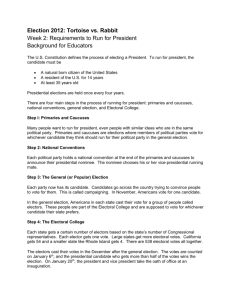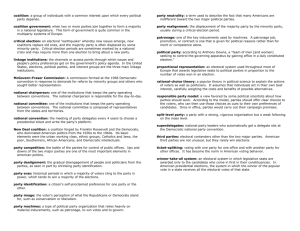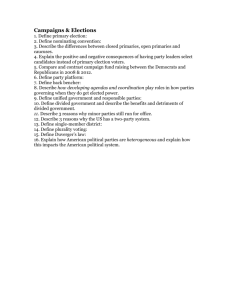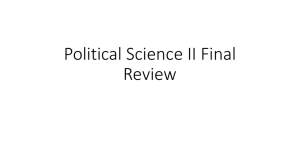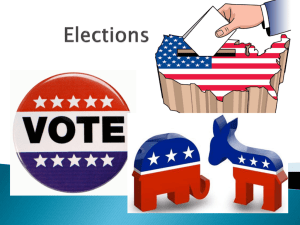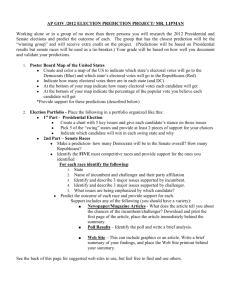Path to the Presidency PPT - HUHS Civics and economics
advertisement
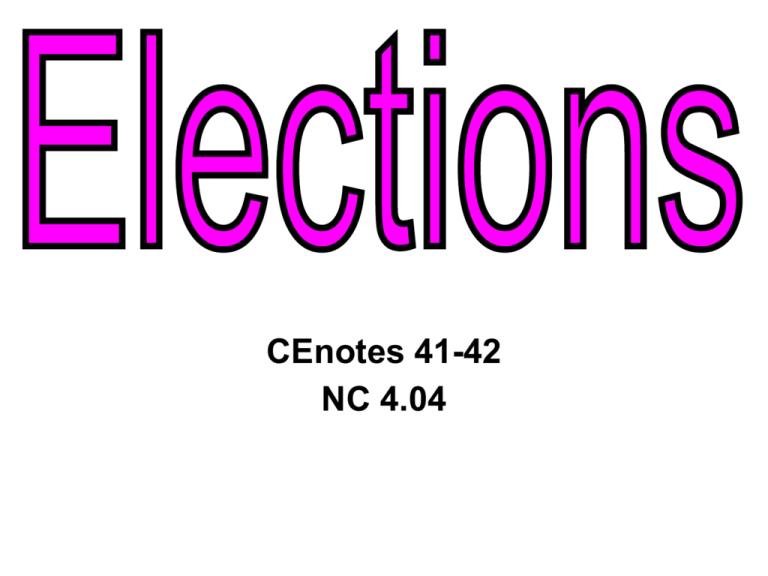
CEnotes 41-42 NC 4.04 • Notes 4-STEP PATH TO THE PRESIDENCY: 1. Announce candidacy: make it public that you are running and begin to build name recognition. President Obama announced his candidacy in his home state of Illinois, where Abraham Lincoln made a famous speech about ending slavery. Where would you announce your campaign? 2. Primaries and Caucuses: Each state holds Republican and Democratic Primaries or caucuses. a) Primary: election where you vote for your choice to represent the party in the general election (open or closed) b) Caucus: meeting where you decide on who should represent the party in the general election. Primary During a primary, people vote to pick the person from the party who they want to run in the general election. • Primaries can be open or closed. Open means all registered voters can participate. Closed means only party members can vote in primary. – Ex: The North Carolina primary is closed, this means that in order to participate voters must be registered with a certain party. – The New Hampshire primary is OPEN this means that it is open to all voters (R, D or independent) Caucus In a caucus people MEET and discuss who they want to elect. There might be several votes. Democratic Primary Debate Republican Primary Debate 3. National Convention: Delegates for each party report at the end of the summer. This is where each party officially announces their nominee for president. Conventions: Each party announces their national candidate for president. RNC 2012 4. General Election: Tuesday following the first Monday in November. Big night where you must win those 270 electoral votes! Notes : • During the General Election you can vote on a “split ticket” or a “straight ticket” – Split: voting for Dems and Reps. – Straight: just voting for ONE party • If I vote a “STRAIGHT” ticket I just fill in the circle next to the party I want to vote for. • Now everyone I voted for will be a…. • If I vote a “split ticket” that means I will vote for some Democrats and some Republicans. Answer! • Where does each party officially announce its candidate/nominee for the presidency? • What is the difference between the Primaries and the General Election? • In the Primaries you are choosing a candidate to represent your party. In the General Election you must pick between the 2 parties. On the campaign trail… – Canvassing: where supporters go out and knock on doors and get people to vote. – Mass Media: (example: TV commercials) reach the most people and can do good or bad. – Retail Politics: REALLY meeting the voters and selling yourself. – Polls: determine where candidates campaign. – Debates: a chance to meet opponent face to face and argue the issues. Retail politics: Sell Yourself! Use your plain folks appeal! You’ll need a plane to get to all 50 states! You’ll also need protection Debates: held during primaries and during the general election What political party are both of these candidates from? So was this debate during the primaries or the general election? General Election Debates What political parties are represented here? – Political Action Committee (PAC): raise $$ for candidates. Can be set up by the party or by business or special interests. – Special Interest groups: Ex=labor unions, religious groups, pro-life groups, proenvironment, pro-guns etc. Raise money & support for candidates who support their issues. • How we elect the president (Article II): – Electoral College: This body is used to elect the Pres/V.P. • Each state gets the # of representatives + # of Senators. – 13 NC representatives + 2 NC Senators = 15 Electoral Votes • Winner Takes All: Whichever candidate wins the most popular votes in that state will receive ALL the electoral votes for the state (Except in Maine & Nebraska) – In 2008, McCain won 49% of the popular vote in NC. Barack Obama won 50% of the popular vote in NC. Who received NC’s Electoral Votes? How many did he win? • There are a total of 538 electoral votes • You must win 270 electoral votes to win Electoral College Cont’d • If there is a 269 to 269 vote tie the House decides the President and the Senate decides the VP (12th Amendment) Electoral College Cont’d • Why did the framers of the Constitution decide to create the Electoral College? 1. Federalism: The Anti-Federalists wanted to make sure the states still had power in the federal gov’t. The Electoral College is designed so that even small states can influence the outcome of an election. – Example: President Obama had to campaign in big states like Ohio and Florida, but he also had to campaign in NH which only has 4 electoral votes so that he would have at least 270 total on election day. Why we use the Electoral College. 2. Fear of a direct popular vote: The Federalists feared that a direct popular vote would be too much power in the hands of the people. They wanted electors to be able to make a thoughtful decision about who should be president. – Today Electors vote the way the people in their state want them to. Electoral College Map 2008 Election Prediction Blue = Dems 210 Red = Rep. 221 Toss-up = 123 votes Final 2008 Election Results Obama: 365 Electoral Votes McCain: 173 Electoral Votes Notes 26 • Criticisms of the Electoral College: 1. Winner takes all is unfair. 2. Since all states have 2 Senators and at least 1 rep that unfairly gives the states with small populations too much influence. – – – Example: In Wyoming there are 170,000 people represented by each electoral vote. In California 670,000 people are represented by each electoral vote. But then if small states didn’t have at least 3 electoral votes no candidate would ever pay attention to that state. Do you think it is fair that 1 electoral vote can represent 700,000 people in one state and then only 200,000 people in another state? 1. Which 5 states have the most electoral votes (greatest to least)____________, ____________, ___________, ____________, ______________. Which 7 states have the least electoral votes (least to greatest)? _____________, ____________, _________________, _______________, _______________. During an election what does it mean when the media calls a state a “blue state” or a “red state” 2. 3. – – Blue state: Red state: 4. If you were running for president and polls showed that you were ahead by 20 percentage points in California and New York would you spend money campaigning there? Explain why or why not. 1. Do you think the winner-take all system is fair, why or why not? Electoral Map EOC Practice 4. What is the purpose of a primary election? a) to determine public opinion b) to elect state and local officials c) to determine each party’s candidate in the general election d) to determine which political party will win the general election EOC Practice 5. Which of the following best describes the point where both the parties make their nominees to the presidency official? a) b) c) d) Primary election Declaration of candidacy General election National convention EOC Practice 6. What is the sequence of events during a presidential election year? a) general election, primary election, votes cast in the Electoral College, national convention b) national convention, primary election, votes cast in the Electoral College, general election c) primary election, national convention, general election, votes cast in the Electoral College d) votes cast in the Electoral College, primary election, national convention, general election EOC Practice 7. How are caucuses different from primaries? a) Primaries can only be held in states after the initial caucus has taken place. b) Primaries are used in large states where voters select candidates at the same time. c) Caucuses do not have the power to designate a political candidate as a party's caucus winner. d) Caucuses are informal gatherings of voters where discussions and support for candidates can be debated EOC Practice 9. Which of the following allows voters to choose candidates from either political party? a) closed primary election b) general election c) primary election d) Electoral college
